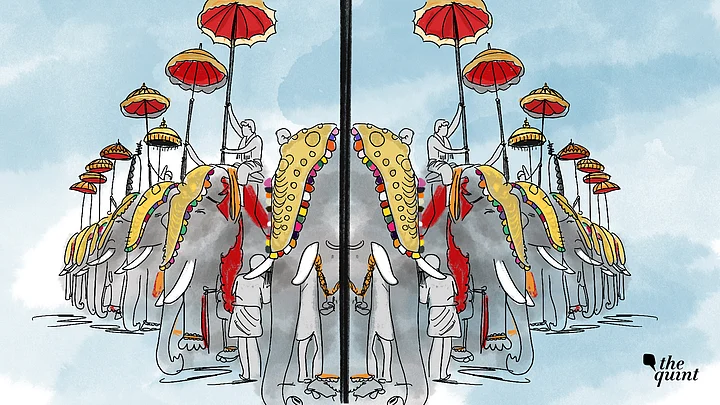Kerala, often lauded by others – and Malayalis themselves – for its highly-educated population, has gotten entangled in two public debates which have shaken the foundation of this status of the community.
The first one was in the form of the huge protests taken out by a section of the community against the Supreme Court verdict allowing women to enter the Sabarimala shrine. The second one is the more recent debate against the forest officials‘ refusal to allow one ageing elephant with low eye-sight from participating in Thrissur Pooram, one of the biggest temple festivals in Kerala.
Tired of reading? Listen to the full story here!
The first debate divided Kerala on communal lines in an unprecedented way (a confirmation for which we may have to wait till the elections results on 23 May), and the second debate has left those environmentally aware to feel pity for Kerala.
The matter is simple. Thechikkottukavu Ramachandran, the elephant considered to be the tallest domesticated Asiatic elephant, at 316 cm height, was prohibited from participating in a festival for his failing vision, as it might harm the public and the mammal itself as well.
But succumbing to social pressure, the ban is now revoked and the 54-year-old troubled elephant that has trampled upon 14 people since the 1990s is going to be put under duress again!
Age-Old Tryst With Tuskers
Kerala’s official emblem is adorned by two elephants. One of the tuskers in that created issues in 1957 when the government led by EMS Nampoothiripad decided to have a new emblem for the unified Kerala. The new design that was proposed had only one tusker in it, whereas the emblem of erstwhile Travancore kingdom, the royalty in the southern Kerala, had two tuskers.
Due to the unrest from a section of society, the first elected communist Government in the world had to change the decision and retain the left tusker as well. Here in 2019, another government led by the Communists did a similar retreat.
The 1957 decision was not harmful as it was about a pictorial elephant, but this time it is a living elephant that deserves peace for the rest of his life after ornamenting Malayali’s festival grounds for decades.
Obsession With The Male Elephant
Kerala’s obsessions have always had a gender bias and same is the case with its fascination for the big mammal. As per records, the state has more than 900 domesticated elephants and more than 95 percent of them are tuskers. The obsession with the male elephant is obvious.
The heavy-moustached hero in the male-centric Malayalam commercial film industry was also made to behave like a tusker in ‘musth’ (a periodic condition in male elephants, characterised by highly-aggressive behaviour), as if all the script-writers have conducted a deep study of ‘Matanga Lila’, the basic text in Sanskrit on Elephant behaviour.
Despite the fact that Kerala has the maximum shrines for the Mother Goddess, very few have kept female elephants.
In fact, the elephant economy in Kerala does not just depend on its festivals, though Kerala has the maximum festival days in a calendar year with a large number of rich shrines across religions.
Owning a tusker had another benefit as the green state was known for its timber industry since the beginning of the last century. However, mechanisation has resulted in major shifts in the timber industry and now tuskers are seldom used for logging operations.
Thus, a need has arisen for more festivals in Kerala with participation of more elephants to sustain the elephant economy. We can see this change in the last decade-- more festivals, newly found rituals, huge flex boards praising big tuskers with Sanskritised attributes.
The newly-found fascination for elephants is a manufactured one, sadly causing trouble for the animal.
Literature Sympathised With Captured Elephants
There is no easy solution to the problem. The political atmosphere in Kerala at the moment is volatile and the communal elements are waiting to twist any situation for their benefit. But popular media and literature in Kerala aptly captured the relationship between the man and the mammal.
Case in point is a documentary film titled, The Catch, made by G Aravindan in 1986. He picturised the last government controlled elephant capturing in Kerala for the film.
I remember a scene from the film, where a mother elephant was refusing to get into the man’s trap. But even after 1986, Kerala many more elephants from different parts of India. Why?
A number of legendary stories are woven around ‘man-elephant relationship’ in Kerala. Kottarathil Sankunni (1855-1937), author of Aithihya Maala (A Garland of legends) , wrote more than a century back, on famous man-elephant relationships around elephants like Kidangoor Kandankoran, Vaikom Gangadharan, Ettumanur Chandrasekharan and so on.
Vailoppilli Sridhara Menon (1911-1985), one of the path-breaking modern Malayalam poets, wrote ‘Sahyante Makan’ (Son of the Western Ghats) way back in 1944 on a domesticated elephant dreaming about its forest and walking freely in a festival ground thinking that it was his home turf resulting in the police killing him with a gunshot.
The poem depicts in its intensity the story of elephants in captivity.
Let me try and translate the last verses of the poem:
“The Man’s gun roared, the elephant fell.
Did the tusker’s wail reach the man’s God in slumber?
But it echoed from the paternal hearts of the Western Ghats.”
( S Gopalakrishnan is a Sahitya Academy award winning author in Malayalam, mostly writes commentaries on Gandhi, Music and current affairs. This is an opinion piece and the views expressed above are the author’s own. The Quint neither endorses nor is responsible for the same. )
(At The Quint, we question everything. Play an active role in shaping our journalism by becoming a member today.)
